
Virgin Coconut Oil
Coconut palms are grown widely in the coastal tracts of Kerala. Copra, the dried kernel is the chief commercial product from Coconut, which is mainly used for oil extraction. Copra normally has an oil content varying from 65 to 72 per cent. The quality of an ISO certified Coconut Oil is related to the quality of Copra we use. Oil can be extracted by smoke drying, sun drying, or kiln drying, or derivatives or a combination of these three. We use most modern technology and machineries for this purpose. It is well purified, by filtering process and perfectly refined Coconut oil is obtained. It is left for natural settling and then filtered in a filter press and then again subjected to micro filtering and thereafter transferred to storage tanks for packing. Health Benefirs fo Cocnut Oil Natural Coconut Oil has innumerable uses. It is used as edible oil; it is an excellent moisturizer and skin softener. This makes it an ideal ingredient in several cosmetics. The Organic Coconut Oil manufactured from the fresh Coconut seeds is highly beneficial to health. Since ages, it has been recommended as hair oil. In fact, in Kerala - India food is commonly cooked in oil from the coconuts. Researchers from the medical field are studying the benefits of the organic form of unrefined coconut oil. Initial trials have confirmed that unrefined coconut oil or monolaurin has an anti-viral effect. A minimum of 50ml of unrefined coconut oil would contain 20 to 25 grams of lauric acid, which indicates that the oil is metabolized in the body to release monolaurin which is an antibiotic and an antiviral agent. Among the saturated fatty acids, lauric acid has the maximum antiviral activity. It is also very good massage oil. Consequently, we are in the trade of Wholesale Coconut Oil. We are among the prominent Exporters of Coconut oil. Refined Coconut Oil Most commercial grade coconut oils are made from copra. Copra is basically the dried kernel (meat) of the coconut. It can be made by: smoke drying, sun drying, or kiln drying, or derivatives or a combination of these three. If standard copra is used as a starting material, the unrefined coconut oil extracted from copra is not suitable for consumption and must be purified, that is refined. This is because the way most copra is dried is not sanitary. The standard end product made from copra isRBD coconut oil. RBD stands for refined, bleached, and deodorized. High heat is used to deodorize the oil, and the oil is typically filtered through (bleaching) clays to remove impurities. Sodium hydroxide is generally used to remove free fatty acids and prolong shelf life. This is the most common way to mass-produce coconut oil. The older way of producing refined coconut oil was through physical/mechanical refining and modern methods also use chemical solvents to extract all the oil from the copra for higher yields. RBD oil is also sometimes hydrogenated or partially hydrogenated. This happens mostly in tropical climates, since the natural melting point of coconut oil is about 76 degrees F, and already naturally a solid in colder climates. Since coconut oil is mostly saturated, there is little unsaturated oil left to hydrogenate. Hydrogenated oils contain trans fatty acids. Virgin Coconut Oil There is no industry standard definition for "Virgin Coconut Oil" as there is in the olive oil industry for "Virgin" and "Extra Virgin" olive oil. Today, there are many coconut oils on the market that are labeled as "Virgin Coconut Oil." Virgin Coconut Oil can only be achieved by using fresh coconut meat or what is called non-copra. Chemicals and high heating are not used in further refining, since the natural, pure coconut oil is very stable with a shelf life of several years. There are currently two main processes of manufacturing Virgin Coconut Oil: 1. Quick drying of fresh coconut meat which is then used to press out the oil. Using this method, the coconut meat is quick dried, and the oil is then pressed out via mechanical means. This is the most common type of "Virgin" or "Extra Virgin" coconut oil sold in the market today that you will find in stores. 2. Wet-milling. With this method the oil is extracted from fresh coconut meat without drying first. "Coconut milk" is expressed first by pressing. The oil is then further separated from the water. Methods which can be used to separate the oil from the water include boiling, fermentation, refrigeration, enzymes and mechanical centrifuge. Other Details
Country of Origin : India
...more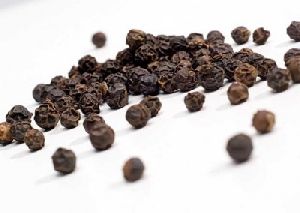
Black Pepper
Pepper occupies an important position in the cuisines of both East and West. It is also widely used as a food preservative. With its antioxidant, anti-microbial, analgesic, anti-pyretic and anti-inflammatory properties, it has wide applications in pharmaceutical products and in Ayurveda. No wonder Indian Pepper fascinated the world from ancient times.Indigenous to India, pepper, rightly called the King of Spices, is one of the oldest and best-known spices in the world. India has always reigned supreme in the production and export of this most exotic and sought-after spice Pepper. Indian pepper had a profound influence on the European economy of the middle Ages. Many western countries owed their prosperity to this spice, which fetched them a very high price. Easily the finest in quality anywhere, Indian pepper is grown in the monsoon forests along the Malabar Coast in South India. Here, a combination of natural advantages and organic techniques produces bigger, better shaped, more aromatic and flavorful berries. We offer the following varieties of pepper a) Telllcherry Garbled Black Pepper (TGSEB, TGEB, TG ) b) Garbled Malabar Black Pepper ( MG 1 , MG 2 ) c) Ungarbled Malabar Black Pepper ( MUG 1 ,MUG 2,MUG 3 L,MUG 4L ) d) Garbled Light Black Pepper (GL Special - GL 1, GL 2, GL 3 ) e) Ungarbled Light Black Pepper (UGL Special - UGL 1, UGL 2 L ) f) White Pepper Other Details q
Certification : ASTA or as required by the buyer
...more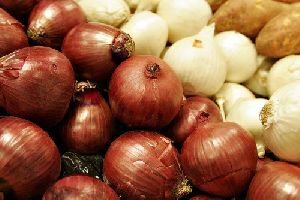
Onion
Onion is the largest vegetable produced and consumed not only in India but also in the world. Although, it is classified as vegetable, it has special qualities, which add to taste and flavor to food and hence it is mainly used in India cuisine and culinary preparations. In addition to its use in cuisine, it is also relished in raw form with meals. Onions possess very good nutritive and medicinal values- the nutritive ingredients of onion are as follows (Quantities per 100 gm). There are hundreds of varieties of Onion grown in the world. According to colour, there are red, white and yellow types. Red and white varieties are grown in India. Although, onion is consumed in all the countries of the world, it is cultivated only in some countries. Hence it has export market and export value. Area under onion cultivation in the world is about 20 lakh hectares. India has the largest area of about 4 lakh ha. (20%) followed by China about 3 lakh ha. But the production is the highest in China (48 lakh MT) as against India (44 lakh MT) due to higher productivity in China (16 MT/ha than India 14 MT/ha). In India, of the four lakh hectares of area under onion, the maximum area of about 95,000 ha (about 24%) is in Maharashtra. Other important states are Karnataka, Orissa, U.P., Andhra Pradesh, Rajasthan, M.P., Tamil Nadu, Bihar and Gujarat. Varieties of Onion. Big size - 4 to 6 cm. Diameter Medium - 3 to 4 cm. Diameter Small - 2 to 3 cm. Diameter Podisu - 2.5 to 3.5 cm. Diameter The varieties of onion available for export from India are Big Onion Varieties a) Pusa Red b) Agrifound Light Red c) N-2-4-1 Agrifound Dark Red d) N-53, Nasik Local e) Bellary Red Small Onion Varieties a) Agrifound Rose b) Bangalore Rose c) Podisa d) Multore e) Nattu Uniform in size, we provide availability of onion in customized packing and quantities as per customer requirements. Specification of Red Onion: a) Each onion having light and dark red colour The sizes of red onion vary between 30mm to 70mm. b) Packed in 5 Kg/10 Kg/20 kg/25 Kg mesh bag as per customer requirements. c) 13.5 to 15 tons of red onion in one open door 20 feet box container and 40 feet box container contains 26 to 30 tons.For long duration voyage refrigerated box container are preferred. d) 1 Kg of red onion consists of 12 to 13 onion of 45-50mm. i.e. 13.5 tons in 20 feet one door box container.
Country of Origin : India
Packaging Type : PP or Jute Bags
...more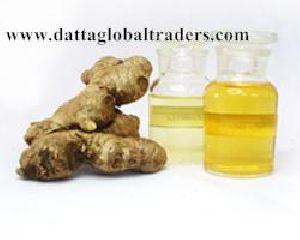
Ginger Oil
Ginger essential oil is extracted from the plant Zingiberaceae officinale of the Zingiberaceae family and is also known as Common or Jamaica Ginger. Ginger oil can vary in color from pale yellow to a darker amber color and the viscosity also ranges from medium to watery. It is strong smelling oil - spicy, sharp, and warm with a hint of lemon and pepper, which smells of actual ginger. Extraction The oil is extracted by means of steam distillation from the unpeeled or dried, ground-up root (rhizome) of the plant, and can yield about 2 - 4 % oil. Chemical composition The essential oil has various chemical constituents including the following: a-pinene, camphene, b-pinene, 1, 8-cineole, linalool, borneol, y-terpineol, nerol, neral, geraniol, geranial, geranyl acetate, b-bisabolene and zingiberene. Uses Ginger oil is used in the treatment of fractures, rheumatism, arthritis, bruising, carbuncles, nausea, hangovers, travel and sea sickness, colds and flu, catarrh, congestion, coughs, sinusitis, sores on the skin, sore throat, diarrhea, colic, cramps, chills and fever. Ginger oil is well suited to help ease colds and flu, nausea, motion sickness, morning sickness, muscle aches and pains, as well as poor circulation and arthritic pain. Since ginger oil strong smells, it can overpower weaker oils, but blends well with all citrus and spicy oils such as bergamot, frankincense, neroli, rose, Sandalwood and Ylang-Ylang.
Country of Origin : India
Certification : ASTA or as required by the buyer
...more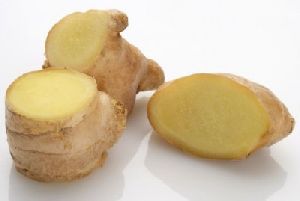
Ginger
Ginger has a long history in India where they used it in much kind of dishes and Ginger is not found in the wild, its origins are uncertain. It is likely to have originated from India as Ginger plants there show the most biological variability. Ginger is the herbaceous perennial belonging to Zingiberaceae family. Ginger of commerce usage is the dried rhizome of the plant which is used as a Spice. Serving as a rich appetizer and an effective drug, Ginger is widely known as one of the oldest spices. It is widely cultivated in India and is marketed as a dried spice. Ginger has been cultivated in India both as a fresh vegetable and marketed as a dried spice since time immemorial. Though grown all over India, the finest quality ginger comes from Kerala endowed as it is with a congenial climate and a rich earthy soil. Indian dry ginger is known in the world market as 'Cochin Ginger' (NUGC) & 'Calicut Ginger' (NUGK). India offers ginger in a variety of forms; oils, oleoresins, fresh ginger in brine, pickles, candies and syrups. It also comes in garbled/Ungarbled, bleached/unbleached and powder forms. India has a predominant position in ginger production and exports.
Country of Origin : India
...more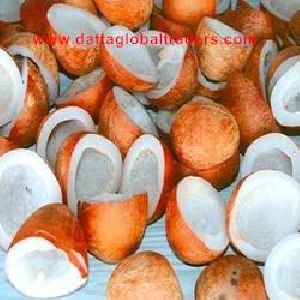
Dry Coconut
Two types of copra namely milling and edible are made in India. Milling copra is used to extract oil while edible grade of copra is consumed as a dry fruit and used for religious purposes. Milling copra is generally manufactured by adopting sun drying and artificial means. Substantial quantity of milling copra is manufactured using modern hot air driers resulting in the availability of superior quality copra which is required for the manufacture of best grade coconut oil. A good number of farmers' co-operative societies are also involved in the manufacture and marketing of milling copra. Milling copra is available in different grades. Edible copra is made in the form of balls and cups. Different grades of edible copra are available in the market according to the size, colour etc. We provide a high quality range of Milling Copra, which is appreciated by the customers due to its nutrition content. Prepared by the process of drying the stored coconut ( Copra drying ) with husk by smoke, sun or kiln, our Milling Copra is specially used to extract oil. Apart from Milling Copra, we can supply large quantities of edible copra and oil copra as well. Specialty: High oil content Minimum moisture content Nutritional benefits (high in protein) Made from the finest mature coconuts Suitable to treat animal diseases Required For: Oil extraction Animal feed Other Details
Country of Origin : India
Certification : ASTA or as required by the buyer
...more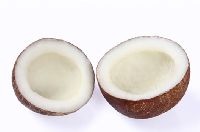
copra dryer
Two types of copra namely milling and edible are made in India. Milling copra is used to extract oil while edible grade of copra is consumed as a dry fruit and used for religious purposes. Milling copra is generally manufactured by adopting sun drying and artificial means. Substantial quantity of milling copra is manufactured using modern hot air driers resulting in the availability of superior quality copra which is required for the manufacture of best grade coconut oil. A good number of farmers' co-operative societies are also involved in the manufacture and marketing of milling copra.
...more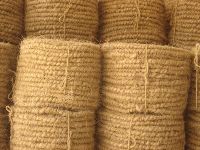
Coir Curling Machine
Coir rope-making is a common cottage industry in India. This is where a family works together from their home. They actually work outside, somewhere with plenty of space to stretch out the lengths of rope and preferably with shade, like under big trees. The Coconut fibre is attached to hooks on a wheel that is turned by hand. This twists the coir while more is added. It forms a strong rope that doesn’t unwind or break.
...more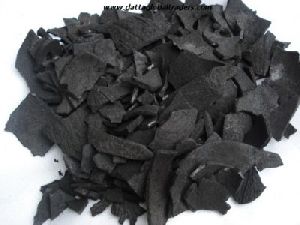
coconut shells charcoal
Coconut Charcoal is an important product obtained from coconut shell. Shell charcoal is used widely as domestic and industrial fuel. It is also used by blacksmiths and goldsmiths and in laundries. Shell Charcoal is also used to produce activated carbon. Activated Carbon produced from coconut shell has certain specific advantages as the raw material can adsorb certain molecular species. Shell is carbonized by using methods like pit method, drum method, destructive distillation etc. The shell charcoal is the raw material required for the manufacture of activated carbon. The shell charcoal is manufactured by burning shells of fully matured nuts in limited supply of air sufficient only for carbonization, but not for complete destruction.The output of charcoal in the traditional pith method is just below 30 per cent of the weight of the original shells. In India the average output in the traditional method has been found to be 35kg of charcoal from 1000 whole shells or about 30,000 whole shells yield 1 tone of charcoal. Sometimes, especially when the processing is defective, the output is still lower and nearly 50,000 shells are required to produce one tone of charcoal. To obtain good quality charcoal, fully dried, clean, mature shells should be used. Now several modern methods are in vogue for the production of charcoal. In the modern waste heat recovery unit the heat generated by the burning of coconut shells is used for drying copra and shell charcoal is obtained as by-product. Product Specification
...more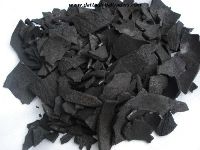
Coconut Shell Products
Coconut Charcoal is an important product obtained from coconut shell. Shell charcoal is used widely as domestic and industrial fuel. It is also used by blacksmiths and goldsmiths and in laundries. Shell Charcoal is also used to produce activated carbon. Activated Carbon produced from coconut shell has certain specific advantages as the raw material can adsorb certain molecular species. Shell is carbonized by using methods like pit method, drum method, destructive distillation etc. The shell charcoal is the raw material required for the manufacture of activated carbon.
...more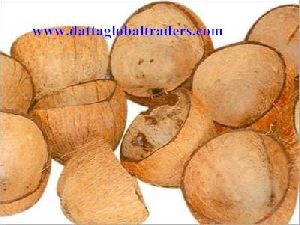
Coconut Shell
We are one of the leading exporters of Coconut shell which is mainly used for maling handicrafts and Cocnut shell charcoal. Natural coconut shell is cut horizontally, hygienically cleaned inside and outside , and then dried. Standard size: 185 ML to 200 ML (5 ounces), or 3.5" - 5" 1/2 coconut shell with fiber . Each box will contain 200 - 250 shells.
Country of Origin : India
Certification : ASTA or as required by the buyer
...more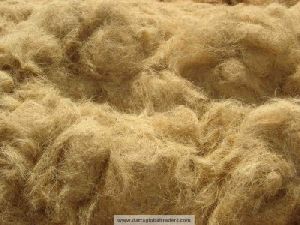
Coconut Fiber
We are exporter of Coconut Fiber or Coconut Pith from India.Coconut fiber is mainly used to make coconut coir and other coconut fiber products like carpets. Coir is the fibrous husk of the coconut shell. Being tough and naturally resistant to seawater, the coir protects the fruit enough to survive months floating on ocean currents to be washed up on a sandy shore where it may sprout and grow into a tree, if it has enough fresh water, because all the other nutrients it needs have been carried along with the seed. These characteristics make the fibers quite useful in floor and outdoor mats, aquarium filters, cordage and rope, and garden mulch. The individual fibre cells are narrow and hollow, with thick walls made of cellulose. They are pale when immature but later become hardened and yellowed as a layer of lignin, is deposited on their walls. Mature brown coir fibres contain more lignin and less cellulose than fibres such as flax and cotton and so are stronger but less flexible. They are made up of small threads, each less than 0.05 inch (1.3 mm) long and 10 to 20 micrometers in diameter. White fibre is smoother and finer, but also weaker. The coir fibre is relatively waterproof and is the only natural fibre resistant to damage by salt water. The fibrous layer of the fruit is then separated from the hard shell (manually) by driving the fruit down onto a spike to split it (De-husking). Machines are now available which crush the whole fruit to give the loose fibres. Brown fibre Brown fibre is obtained by harvesting fully mature coconuts when the nutritious layer surrounding the seed is ready to be processed into copra and desiccated coconut. The fibrous husks are soaked in pits or in nets in a slow moving body of water to swell and soften the fibres. The long bristle fibres are separated from the shorter mattress fibres underneath the skin of the nut, a process known as wet-milling. The mattress fibres are sifted to remove dirt and other rubbish, dried and packed into bales. Some mattress fibre is allowed to retain more moisture so that it retains its elasticity for 'twisted' fibre production. The coir fibre is elastic enough to twist without breaking and it holds a curl as though permanently waved. Twisting is done by simply making a rope of the hank of fibre and twisting it using a machine or by hand. The longer bristle fibre is washed in clean water and then dried before being tied into bundles or hunks. It may then be cleaned and 'hackled' by steel combs to straighten the fibres and remove any shorter fibre pieces. Coir bristle fibre can also be bleached and dyed to obtain hanks of different colors. White Fibre Green Coconuts harvested after about six to twelve months on the planet contain pliable white fibres. The immature husks are suspended in a river or water-filled pit for up to ten months. During this time micro-organisms break down the plant tissues surrounding the fibres to loosen them - a process known as retting. Segments of the husk are then beaten by hand to separate out the long fibres, which are subsequently dried and cleaned. Cleaned fibre is ready for spinning into yarn using a simple one-handed system or a spinning wheel. Varieties Long Coir fibre Cut fibre or Short Coir Bristle Coir Fibre Specifications of Coir Fibres:
Color : brown and golden brown
Fiber Length : 5 cm to 20 cm, 50 mm to 200 mm, 2 ½" to 8"
...more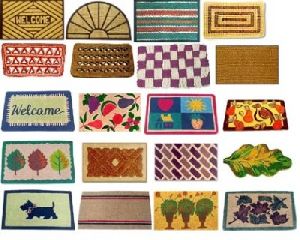
coconut coir mats
Country of Origin : India
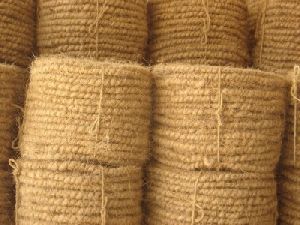
coconut coir
Coir is a natural fibre extracted from the husk of coconut and used in products such as floor mats, ropes, doormats, brushes, mattresses etc. Technically coir is the fibrous material found between the hard, internal shell and the outer coat of a coconut. Other uses of brown coir (made from ripe coconut) are in upholstery padding, sacking and horticulture. White coir is harvested from unripe coconuts, and is used for making finer brushes, string, rope and fishing nets. Coir rope-making is a common cottage industry in India. This is where a family works together from their home. They actually work outside, somewhere with plenty of space to stretch out the lengths of rope and preferably with shade, like under big trees. The Coconut fibre is attached to hooks on a wheel that is turned by hand. This twists the coir while more is added. It forms a strong rope that doesn’t unwind or break. Coir rope is 100 % Natural Coir rope has excellent elasticity properties Coir rope is naturally resistant to insect infestations Coir rope is can absorb water without weakening Coir rope is naturally resistant to salt water damage Coir rope is sustainably eco-friendly Coir rope and coir strings' hairiness improves growth of crops and a better yield Coir rope has been used successfully in Hops growing for decades Specification of Rope: Diameter starts from 5mm to 50mm Length starts from 1 feet to 100 feet Standard length is 20 feet Machine twisted rope Curls are 18 to 26 curls per feet Moisture 15- 17% max
Country of Origin : India
...more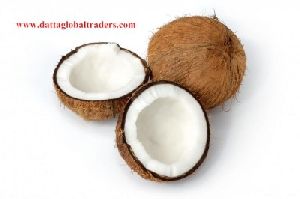
Coconut
Traditional areas of coconut cultivation in India are at 4 southern states , put together account for almost 92% of the total production in the country: Kerala (45.22%), Tamil Nadu (26.56%), Karnataka (10.85%), and Andhra Pradesh (8.93%).Other states like Goa, Maharashtra, Orissa, West Bengal, and those in the northeast like Tripura and Assam account for the remaining 8.44%. Kerala, which has the largest number of coconut trees, is famous for its coconut-based products like coconut water, copra, coconut oil , coconut cake (also called coconut meal, copra cake, or copra meal), coconut toddy, coconut shell-based products, coconut wood-based products, coconut leaves, and coir pith. We offer the following varieties of Indian Coconuts- 1. Fresh Coconuts 2. Young Coconuts 3. Semi Husked Coconuts 4. Mature Coconuts Specification :
Weight : 625 - 700 gms
...more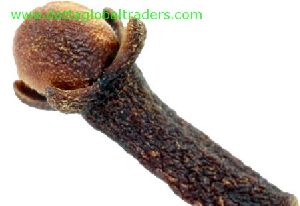
Clove
We are producers and exporters of green clove ( whole , powdered and clove oil ). The Cloves ( Syzygium Aromaticum ) have enormous medicinal uses. These are very effective in skin problems like acne, pimples etc. The oil extracted from the Dried Cloves is used in curing various dental diseases and toothache. The best quality cloves are collected from Kerala ( India ) and processed and packaged in hygienic conditions. Uses for Cardamom Various natural nutrients Pungent taste Strong aroma Medical properties Culinary purposes Health Benefits of Clove Good source of manganese, vitamin C, K, dietary fiber, calcium and magnesium Effective and natural anti-fungal Excellent anesthetic properties Prevents cancer Beneficial in mild cough Remedy for tooth ache Clove Oil or Essential Clove oil has many health and medicinal benefits. Other Details
Country of Origin : India
...more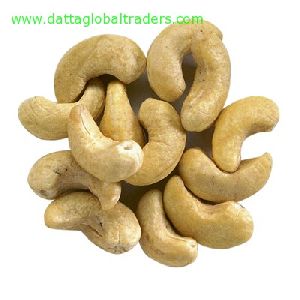
cashew nuts
The Cashew tree (Anacardium Occidentale), is a tropical evergreen native to the Americas but is now widely cultivated in Asia and Africa. It is a short, stocky, low-spreading, evergreen tropical tree. Four centuries ago, the adventurous Portuguese came sailing down the Indian coasts and brought with them this valuable tree nut "Cashew", the Favorite nut of the world. Cashew came, conquered and took deep roots in the entire coastal region of India. Cashew found the Indian soil more homely than its homeland. Later it spread as a popular crop to other parts of India. HARVEST, POSTHARVEST HANDLING Maturity The cashew apple and nut abscise from trees naturally when ripe. Maturation occurs over a period of several weeks during the dry season. Harvest Method Nuts are collected from the ground by hand. Frequent passes though the planting must be made if apples are to be utilized, as they are highly perishable. Rain at harvest may increase rot and stimulate nut germination. Postharvest Handling The presence of caustic cashew nut shell liquid (CNSL) in the shells makes cashew processing more difficult and hazardous than for other nut crops. After harvest, the nuts are dried in the sun or in simple tray driers and stored for processing later. Dried nuts can be stored for about 2 years at room temperature after reaching water contents of 5-10%. Nuts are re-hydrated partially by soaking or storing in high humidity since this facilitates extraction of whole kernels and CNSL. Nuts are separated by size before roasting to ensure uniformity of the roasting process. After roasting, nuts are shelled either by hand or in machines. Storage Vacuum packed, roasted nuts can be stored for up to one year, and carbon dioxide packing extends life an additional year. We offer the following varieties of Indian Cashew Nuts (A) CASHEW KERNELS - WHITE WHOLES 1. White Wholes – 180 2. White Wholes – 210 3. White Wholes – 240 4. White Wholes – 320 5. White Wholes - 450 6. White Wholes – 500 (B) CASHEW KERNELS - SCORCHED WHOLES 1. Scorched Wholes – 180 2. Scorched Wholes – 210 3. Scorched Wholes – 240 4. Scorched Wholes – 320 5. Scorched Wholes – 450 6. Scorched Wholes – 500 (C) CASHEW KERNELS - DESERT WHOLES 1. Scorched Wholes Seconds (SSW) 2. Dessert Wholes (DW) (D) CASHEW KERNELS - WHITE PIECES 1. Butts (B) 2. Splits (S) 3. Large White Pieces (LWP) 4. Small White Pieces (SWP) 5. Baby Bits (BB) (E) CASHEW KERNELS - SCORCHED PIECES 1. Scorched Butts (SB) 2. Scorched Splits (SS) 3. Scorched Pieces (SP) 4. Scorched Small Pieces (SSP) (F) CASHEW KERNELS - DESSERT PIECES 1. Scorched Pieces Seconds (SPS) 2. Dessert Pieces (DP) Other Details
Country of Origin : India
Certification : ASTA or as required by the buyer
...more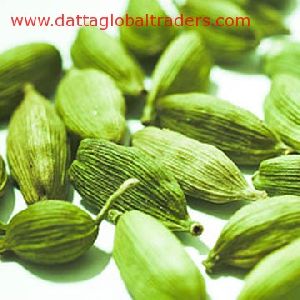
Cardamom
Cardamom is a reputed fruit that grows on the cardamom plant and is used as an exquisite flavored spice all around the globe. It is considered as the “Queen of spices”, it being a highly prized spice as well. The cardamom plant is a long living tropical herb plant belonging to the ginger family Zingiberaceae and grows from a thick rootstalk up till around 6 to 10 feet. The fragrance of cardamom is also well recognized everywhere and it is used as a mouth freshener. Cardamom plant has dark green long leaves and also a long flowering stalk and bear fruits that are pale green or yellowish in color, elongated in shape. These ripen fruits are the ones which are used as spice and flavoring. Cardamom’s reputation as a spice is unmatchable as it is one of the highly priced and most expensive spices after vanilla and saffron and often termed as “Queen of spices” as mentioned above. It is considered as a versatile spice as it is used in both sweet and salty foods. Oil from the seeds of cardamom and also the left over resin have their usage in processed foods, tonics, liquors and perfumes. This fruit also has a great significance in the Ayurvedic medicines as it has got healing effects also as in teeth and gum infections, digestive disorders etc. Indian cardamom market India holds the credit of being the country that, for the very first time, discovered cardamom and made it famous in the world. The country has been a key player in each an every context related to cardamom whether it is production, consumption or deciding prices. The country’s earliest medical references found out the healing properties in cardamom and also found out its uses in medicines and other preparations. Cardamom has also been related to spirituality of the people in the country as this was the spice that was offered in the ceremonies and rituals held in the ancient India. India has been producing this reputed spice since a long time and was the leading producer till 2002. It still is the second largest producer of cardamom after Guatemala and its production hovers around 11500 metric tons. Kerala is the largest producer of cardamom in the country producing around 8000 tons of the spice. The production has decreased as compared to the previous times when it touched around 12000 tons in 2002-03. The country has the maximum area covered in the cultivation of cardamom as compared to any country in the world. India stands at the 2nd place in the world consumption list also as it consume almost 90% of the domestic consumption. The maximum demand comes from the western part of the country at around 45% followed by the northern part constituting about 35%.
...more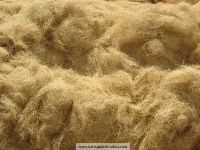
bristle coir fibre
Coir is the fibrous husk of the coconut shell. Being tough and naturally resistant to seawater, the coir protects the fruit enough to survive months floating on ocean currents to be washed up on a sandy shore where it may sprout and grow into a tree, if it has enough fresh water, because all the other nutrients it needs have been carried along with the seed. These characteristics make the fibers quite useful in floor and outdoor mats, aquarium filters, cordage and rope, and garden mulch.
...more
cashew nut

Coconut Products

Spices

tea leaf
Be first to Rate
Rate ThisOpening Hours